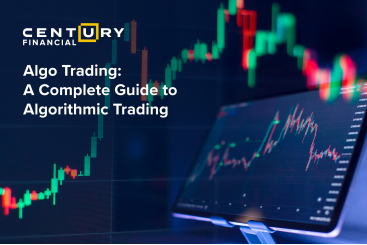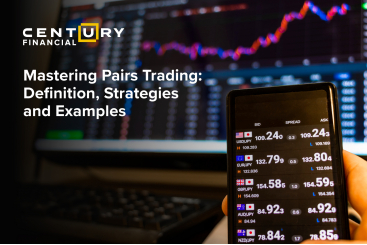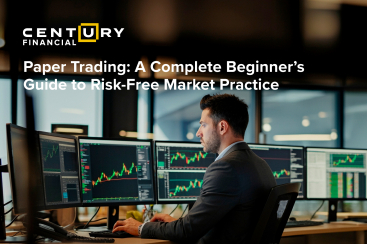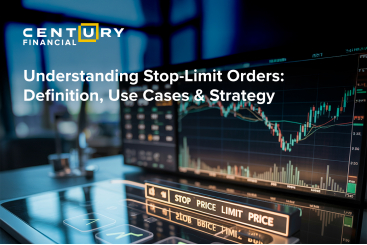Tuesday, December 13, 2022
Types of forex indicators Every Investor Should Know
By Century Financial in 'Blog'

.jpg)
On a daily basis, the forex trading volume touches nearly $6.6 trillion as per a 2019 survey by Triennial Central Bank on FX and OTC derivative markets. This makes it a lucrative market for many traders. However, many traders look for the exact time to enter the forex market, keeping an eye out in search of the signs that tell them to ‘buy’ or ‘sell’. After all, there is no particular method or way to trade in the forex markets, but you can always use a variety of indicators to know when to buy or sell a currency.
Here are four different market indicators successful forex traders rely upon.
How to use the Moving Average indicator?

When approaching technical analysis, most forex traders will begin using Moving Averages, as it is probably the simplest technical indicator. It helps traders understand trends much more easily, whether a downtrend, uptrend or ranging.
The advantage of using Moving Average as an indicator is that you can organize your settings to adapt to the smoothness of the line. After all, the smoother the line, the slower the reaction to price action, making it a lot more steadier.
Generally, there are two types of moving averages
- Simple moving averages (SMA) – Much smoother
- Exponential moving average (EMA) - Focused on the current price action
Before you begin using Moving Average as your indicator, it is recommended that you test it first. This will ensure you can modify your settings for each currency pair to adapt to market volatility and price action.
.jpg)
.png)
How to add technical indicators to your trading?

Bollinger Bands
Bollinger Bands are valuable tools to identify when a price is moving outside its comfort zone by providing a band within which the price typically trades on. As the width of the band widens and contracts, it reflects the volatility witnessed recently.
Traders assume a wider standard deviation is a sign of higher volatility. This is also known as a ‘Bollinger Bounce’ and indicates a possible retracement. On the other hand, if the bands narrow, it means the given market is stable. This is also known as a ‘Bollinger Squeeze’ and is indicative of an upcoming breakout.
Many forex traders generally use Bollinger Bands to figure out areas of market volatility by relying on SMAs. By applying a standard deviation above and below, traders can understand how volatile a market can be. Compared to other forex scalping indicators, Bollinger Bands are an effective scalping strategy.

Stochastic Oscillator
The Stochastic Oscillator helps you identify where the direction of the price is moving. It is often known as the ‘momentum indicator’ as it gives you an idea of the underlying momentum as to why a price has moved.
To make the most of this indicator, it is best to look for signs that prove the market is oversold or overbought. Within a boundary of 0-100, the stochastic oscillates an ‘oversold market’ when the readings are below 20 and an ‘overbought market’ when the readings are below 80.
However, nothing is as simple as it seems. The indicator is a lot more complex. Depending on the market, there are various ways to use this indicator. Take this, for example, an overbought/oversold reading can be beneficial for a trader in a range-bound market compared to a trending market.


Parabolic stop and reverse (SAR)
The Parabolic Stop and Reserve (SAR) is a technical indicator to explore the best time to enter or exit the market. Displayed as dots, scalpers check potential price movements.
So when red dots are above the current price, it is a signal to sell, indicating we are about to enter a bearish market. However, if the green dots are below the current price, it would mean a buy, as a potential bullish market is just around the corner.
These indicators are great tools to use. However, it is essential to remember that these aren’t always accurate and should not be utterly dependent on them. As a trader, you would need to carry out your own technical and fundamental analysis (for each market) before you open any position.
The content in this blog, including any research, analysis, opinions, forecasts, or other information (collectively, "Information"), is provided by Century Financial Consultancy LLC (CFC) for marketing, educational, and general informational purposes only. It should not be construed as investment advice, a recommendation, or a solicitation to buy or sell any financial instruments.
This Information may also be published across various channels, including CFC’s website, third-party platforms, newsletters, marketing materials, emails, social media, messaging apps, webinars, and other communications. While CFC strives for accuracy, we do not guarantee the completeness, reliability, or timeliness of any content. Any decisions made based on this Information are at your own risk. CFC accepts no liability for any loss or damage arising from its use.
Trading financial products involves significant risk and may not be suitable for all investors. Please ensure you fully understand the risks and seek independent professional advice if necessary.
Please refer to the full risk disclosure mentioned on our website.









.png)
.png)
.png)
.png)


